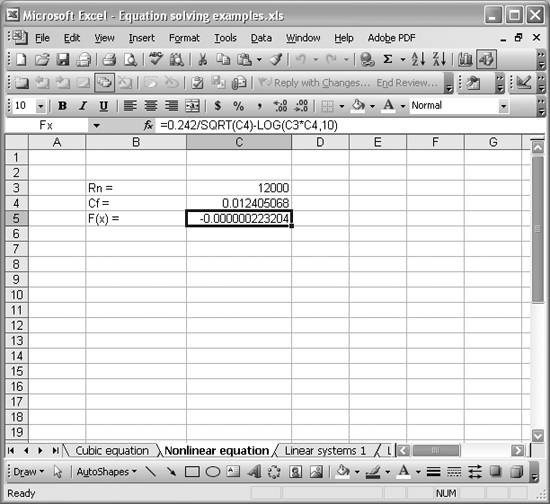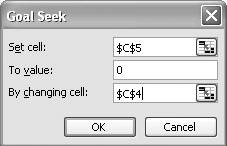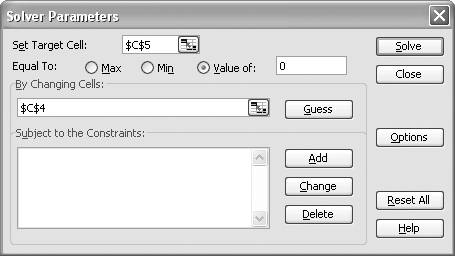Solving Nonlinear Equations Iteratively
Problem
You'd like to solve a nonlinear equation that requires an iterative solution and are not sure how to approach it in Excel.
Solution
Use Goal Seek or Solver. See the introduction to this chapter for more information on how these two tools differ as well as their respective advantages and disadvantages.
Discussion
In this recipe, I want to show you by way of example how to use Excel's built-in Solver and Goal Seek tools to solve a nonlinear equation. The equation we'll consider is:

This equation is used to estimate a frictional drag coefficient, Cf, as a function of the Reynolds number , RN, for some ship resistance calculations. There are other equations for this same purpose but I chose this classical one because it can't be written in an explicit form of y = g(x). Instead, you have to resort to some iterative method to find a value of Cf corresponding to some given value of RN.
I'll show you how to use both Goal Seek and Solver to solve this example problem. In both cases the equation must first be rearranged in the following form:

Now we can use Solver or Goal Seek to iteratively find a value for Cf given a value for RN that makes the righthand side of this equation equal to 0. But first, you need to enter the righthand side of this equation as a spreadsheet formula, as shown in Figure 9-7.
Figure 9-7. Nonlinear equation example

Cell C5 contains a worksheet formula representing the righthand side of our equation. The formula is =0.242/SQRT(C4)-LOG(C3*C4,10), as shown in the formula bar in Figure 9-7. Cell C3 contains the given Reynolds number, while cell C4 contains the corresponding friction coefficient, found using either Solver or Goal Seek. Before actually using Solver or Goal Seek, you should enter your initial guess for the friction coefficient in cell C4. As mentioned in the introduction to this chapter, you should pick an initial guess that is reasonable for the problem at hand.
Finding Cf with Goal Seek
To use Goal Seek to find a solution for this example, select Tools images/U2192.jpg border=0> Goal Seek...from the main menu bar to open the Goal Seek window shown in Figure 9-8.
Figure 9-8. Goal Seek window for nonlinear equation example

In the "Set cell" field, type in C5, or press the little icon to the right of the edit field to temporarily go back to the spreadsheet and click cell C5 to select it (press Enter when you've selected it to return to the Goal Seek window). Remember, cell C5 contains the formula representing the righthand side of our equation, and we want the result of this formula to be zero. Therefore, in the "To value" field, type in 0. That's our target value. Now, set the "By changing cell" field to C4, which contains the friction coefficient value. When you press the OK button, Goal Seek will vary the value in C4 until the formula in C5 is approximately 0. The result for this example is shown in Figure 9-7, where the residual shown in cell C5 is -2.23 x 10-7.
I should mention that my initial guess (i.e., the value I started with in cell C4) was 1 x 10-7. I would have chosen 0 since I know the friction coefficient should be a pretty small number, but I didn't, because it would have resulted in a divide-by-zero error for this problem. Running Goal Seek with the divide-by-zero error would result in Goal Seek failing with a "Formula in cell must result in a number" error.
A residual of -2.23 x 10-7 isn't that bad, but we can do a little better. As discussed in the introduction, you can change the convergence settings for Goal Seek by going to the Options window. Select Tools  Options...from the main menu bar to open the Options window (shown earlier in Figure 9-2). On the Calculation panel, I checked Iteration, set "Maximum iterations to 5,000, and set "Maximum change" to 1 x 10-8. With these settings, Goal Seek finds a solution with a much smaller residual, 1.2 x 10-13. The corresponding coefficient of friction for the given Reynolds number is 0.0124.
Options...from the main menu bar to open the Options window (shown earlier in Figure 9-2). On the Calculation panel, I checked Iteration, set "Maximum iterations to 5,000, and set "Maximum change" to 1 x 10-8. With these settings, Goal Seek finds a solution with a much smaller residual, 1.2 x 10-13. The corresponding coefficient of friction for the given Reynolds number is 0.0124.
Finding Cf with Solver
Goal Seek works well for this simple example, and in practice you would not have to rely on Solver for this problem. For illustration purposes, however, I want to show you how to apply Solver to the same problem. The spreadsheet set up in this case is the same as in the case of using Goal Seek. All you do differently is select Tools images/U2192.jpg border=0> Solver...from the main menu bar to open Solver instead of Goal Seek. The Solver Parameters window for this example is shown in Figure 9-9.
Figure 9-9. Solver Parameters window for nonlinear equation example

Here, I set the Set Target Cell field to C5 and set the Equal To option to a value of 0. Again, C5 contains the righthand side of our equation, which we want equal to 0. Next, I set the By Changing Cells field to cell C4, which contains the initial value for the friction coefficient. Pressing the Solve button initiates the solution process.
Solver does indeed find a solution, yielding a friction coefficient of 0.0124 with a residual of -4.87 x 10-12. These values are comparable with the results obtained using Goal Seek.
Just for fun, try this example again, but this time use an initial guess for the friction coefficient of 1 or 5 or some large number. In this case, Solver actually fails to find a solution! What happens is that Solver overshoots the actual solution and ends up trying a value for the friction coefficient of 0 for an iteration. This of course yields a divide by zero error, which causes Solver to fail prematurely. This little exercise highlights the importance of selecting a reasonable initial guess. It further shows that if your first attempt fails, you should try a different initial guess as the new one might work.
Using Excel
- Introduction
- Navigating the Interface
- Entering Data
- Setting Cell Data Types
- Selecting More Than a Single Cell
- Entering Formulas
- Exploring the R1C1 Cell Reference Style
- Referring to More Than a Single Cell
- Understanding Operator Precedence
- Using Exponents in Formulas
- Exploring Functions
- Formatting Your Spreadsheets
- Defining Custom Format Styles
- Leveraging Copy, Cut, Paste, and Paste Special
- Using Cell Names (Like Programming Variables)
- Validating Data
- Taking Advantage of Macros
- Adding Comments and Equation Notes
- Getting Help
Getting Acquainted with Visual Basic for Applications
- Introduction
- Navigating the VBA Editor
- Writing Functions and Subroutines
- Working with Data Types
- Defining Variables
- Defining Constants
- Using Arrays
- Commenting Code
- Spanning Long Statements over Multiple Lines
- Using Conditional Statements
- Using Loops
- Debugging VBA Code
- Exploring VBAs Built-in Functions
- Exploring Excel Objects
- Creating Your Own Objects in VBA
- VBA Help
Collecting and Cleaning Up Data
- Introduction
- Importing Data from Text Files
- Importing Data from Delimited Text Files
- Importing Data Using Drag-and-Drop
- Importing Data from Access Databases
- Importing Data from Web Pages
- Parsing Data
- Removing Weird Characters from Imported Text
- Converting Units
- Sorting Data
- Filtering Data
- Looking Up Values in Tables
- Retrieving Data from XML Files
Charting
- Introduction
- Creating Simple Charts
- Exploring Chart Styles
- Formatting Charts
- Customizing Chart Axes
- Setting Log or Semilog Scales
- Using Multiple Axes
- Changing the Type of an Existing Chart
- Combining Chart Types
- Building 3D Surface Plots
- Preparing Contour Plots
- Annotating Charts
- Saving Custom Chart Types
- Copying Charts to Word
- Recipe 4-14. Displaying Error Bars
Statistical Analysis
- Introduction
- Computing Summary Statistics
- Plotting Frequency Distributions
- Calculating Confidence Intervals
- Correlating Data
- Ranking and Percentiles
- Performing Statistical Tests
- Conducting ANOVA
- Generating Random Numbers
- Sampling Data
Time Series Analysis
- Introduction
- Plotting Time Series Data
- Adding Trendlines
- Computing Moving Averages
- Smoothing Data Using Weighted Averages
- Centering Data
- Detrending a Time Series
- Estimating Seasonal Indices
- Deseasonalization of a Time Series
- Forecasting
- Applying Discrete Fourier Transforms
Mathematical Functions
- Introduction
- Using Summation Functions
- Delving into Division
- Mastering Multiplication
- Exploring Exponential and Logarithmic Functions
- Using Trigonometry Functions
- Seeing Signs
- Getting to the Root of Things
- Rounding and Truncating Numbers
- Converting Between Number Systems
- Manipulating Matrices
- Building Support for Vectors
- Using Spreadsheet Functions in VBA Code
- Dealing with Complex Numbers
Curve Fitting and Regression
- Introduction
- Performing Linear Curve Fitting Using Excel Charts
- Constructing Your Own Linear Fit Using Spreadsheet Functions
- Using a Single Spreadsheet Function for Linear Curve Fitting
- Performing Multiple Linear Regression
- Generating Nonlinear Curve Fits Using Excel Charts
- Fitting Nonlinear Curves Using Solver
- Assessing Goodness of Fit
- Computing Confidence Intervals
Solving Equations
- Introduction
- Finding Roots Graphically
- Solving Nonlinear Equations Iteratively
- Automating Tedious Problems with VBA
- Solving Linear Systems
- Tackling Nonlinear Systems of Equations
- Using Classical Methods for Solving Equations
Numerical Integration and Differentiation
- Introduction
- Integrating a Definite Integral
- Implementing the Trapezoidal Rule in VBA
- Computing the Center of an Area Using Numerical Integration
- Calculating the Second Moment of an Area
- Dealing with Double Integrals
- Numerical Differentiation
Solving Ordinary Differential Equations
- Introduction
- Solving First-Order Initial Value Problems
- Applying the Runge-Kutta Method to Second-Order Initial Value Problems
- Tackling Coupled Equations
- Shooting Boundary Value Problems
Solving Partial Differential Equations
- Introduction
- Leveraging Excel to Directly Solve Finite Difference Equations
- Recruiting Solver to Iteratively Solve Finite Difference Equations
- Solving Initial Value Problems
- Using Excel to Help Solve Problems Formulated Using the Finite Element Method
Performing Optimization Analyses in Excel
- Introduction
- Using Excel for Traditional Linear Programming
- Exploring Resource Allocation Optimization Problems
- Getting More Realistic Results with Integer Constraints
- Tackling Troublesome Problems
- Optimizing Engineering Design Problems
- Understanding Solver Reports
- Programming a Genetic Algorithm for Optimization
Introduction to Financial Calculations
- Introduction
- Computing Present Value
- Calculating Future Value
- Figuring Out Required Rate of Return
- Doubling Your Money
- Determining Monthly Payments
- Considering Cash Flow Alternatives
- Achieving a Certain Future Value
- Assessing Net Present Worth
- Estimating Rate of Return
- Solving Inverse Problems
- Figuring a Break-Even Point
Index
EAN: 2147483647
Pages: 206
